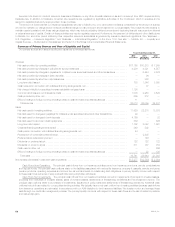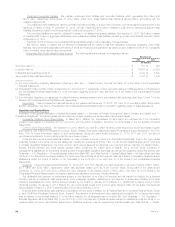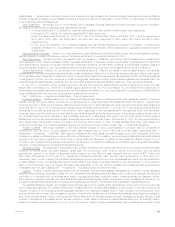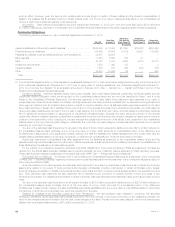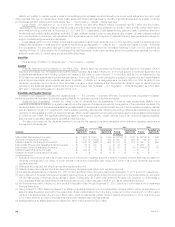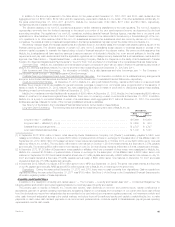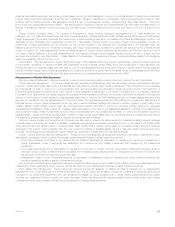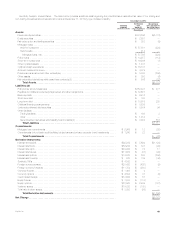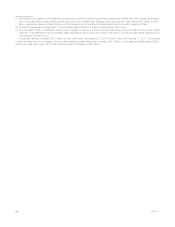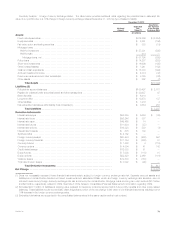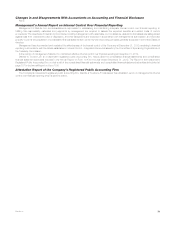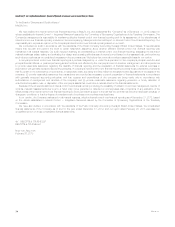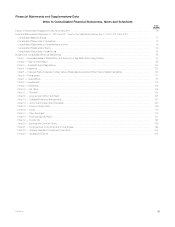MetLife 2012 Annual Report Download - page 71
Download and view the complete annual report
Please find page 71 of the 2012 MetLife annual report below. You can navigate through the pages in the report by either clicking on the pages listed below, or by using the keyword search tool below to find specific information within the annual report.
contributions, if necessary, to MRC so that MRC may at all times maintain its total adjusted capital in an amount that is equal to or greater than 200%
of the company action level RBC, as defined in South Carolina state insurance statutes as in effect on the date of determination or December 31,
2007, whichever calculation produces the greater capital requirement, or as otherwise required by the South Carolina Department of Insurance. See
Note 13 of the Notes to the Consolidated Financial Statements.
MetLife, Inc., in connection with the collateral financing arrangement associated with MetLife Reinsurance Company of South Carolina’s
(“MRSC”) reinsurance of universal life secondary guarantees, committed to the South Carolina Department of Insurance to take necessary action to
cause MRSC to maintain the greater of capital and surplus of $250,000 or total adjusted capital in an amount that is equal to or greater than 100%
of authorized control level RBC, as defined in South Carolina state insurance statutes. See Note 13 of the Notes to the Consolidated Financial
Statements.
MetLife, Inc. has net worth maintenance agreements with two of its insurance subsidiaries, MetLife Investors Insurance Company and First
MetLife Investors Insurance Company. Under these agreements, as amended, MetLife, Inc. agreed, without limitation as to the amount, to cause
each of these subsidiaries to have capital and surplus of $10 million, total adjusted capital in an amount that is equal to or greater than 150% of the
company action level RBC, as defined by applicable state insurance statutes, and liquidity necessary to enable it to meet its current obligations on a
timely basis.
MetLife, Inc. guarantees obligations arising from derivatives of the following subsidiaries: Exeter, MetLife Bank, MetLife International Holdings, Inc.
and MetLife Worldwide Holdings, Inc. These subsidiaries are exposed to various risks relating to their ongoing business operations, including interest
rate, foreign currency exchange rate, credit and equity market. These subsidiaries use a variety of strategies to manage these risks, including the use
of derivatives. Further, all of the subsidiaries’ derivatives are subject to industry standard netting agreements and collateral agreements that limit the
unsecured portion of any open derivative position. On a net counterparty basis at December 31, 2012 and 2011, derivative transactions with
positive mark-to-market values (in-the-money) were $3.2 billion and $4.9 billion, respectively, and derivative transactions with negative mark-to-
market values (out-of-the-money) were $22 million and $51 million, respectively. To secure the obligations represented by the out of-the-money
transactions, the subsidiaries had provided collateral to their counterparties with an estimated fair value of $12 million and $47 million at
December 31, 2012 and 2011, respectively. Accordingly, unsecured derivative liabilities guaranteed by MetLife, Inc. were $10 million and $4 million
at December 31, 2012 and 2011, respectively.
MetLife, Inc. also guarantees the obligations of certain of its subsidiaries under committed facilities with third-party banks. See Note 12 of the
Notes to the Consolidated Financial Statements.
Acquisitions. During the years ended December 31, 2012 and 2011, there were no cash outflows for acquisitions. Cash outflows for
acquisitions during the year ended December 31, 2010 were $7.2 billion. See Note 3 of the Notes to the Consolidated Financial Statements for
information regarding certain of these acquisitions. See Note 23 of the Notes to the Consolidated Financial Statements for information regarding a
pending acquisition.
Adoption of New Accounting Pronouncements
See Note 1 of the Notes to the Consolidated Financial Statements.
Future Adoption of New Accounting Pronouncements
See Note 1 of the Notes to the Consolidated Financial Statements.
Non-GAAP and Other Financial Disclosures
Operating earnings is defined as operating revenues less operating expenses, both net of income tax. Operating earnings available to common
shareholders is defined as operating earnings less preferred stock dividends.
Operating revenues and operating expenses exclude results of Divested Businesses. Operating revenues also excludes net investment gains
(losses) and net derivative gains (losses). Operating expenses also excludes goodwill impairments.
The following additional adjustments are made to GAAP revenues, in the line items indicated, in calculating operating revenues:
‰Universal life and investment-type product policy fees excludes the amortization of unearned revenue related to net investment gains (losses) and
net derivative gains (losses) and certain variable annuity GMIB fees (“GMIB Fees”);
‰Net investment income: (i) includes amounts for scheduled periodic settlement payments and amortization of premium on derivatives that are
hedges of investments but do not qualify for hedge accounting treatment, (ii) includes income from discontinued real estate operations,
(iii) excludes post-tax operating earnings adjustments relating to insurance joint ventures accounted for under the equity method, (iv) excludes
certain amounts related to contractholder-directed unit-linked investments, and (v) excludes certain amounts related to securitization entities that
are VIEs consolidated under GAAP; and
‰Other revenues are adjusted for settlements of foreign currency earnings hedges.
The following additional adjustments are made to GAAP expenses, in the line items indicated, in calculating operating expenses:
‰Policyholder benefits and claims and policyholder dividends excludes: (i) changes in the policyholder dividend obligation related to net investment
gains (losses) and net derivative gains (losses), (ii) inflation-indexed benefit adjustments associated with contracts backed by inflation-indexed
investments and amounts associated with periodic crediting rate adjustments based on the total return of a contractually referenced pool of
assets, (iii) benefits and hedging costs related to GMIBs (“GMIB Costs”), and (iv) market value adjustments associated with surrenders or
terminations of contracts (“Market Value Adjustments”);
‰Interest credited to policyholder account balances includes adjustments for scheduled periodic settlement payments and amortization of premium
on derivatives that are hedges of PABs but do not qualify for hedge accounting treatment and excludes amounts related to net investment income
earned on contractholder-directed unit-linked investments;
‰Amortization of DAC and VOBA excludes amounts related to: (i) net investment gains (losses) and net derivative gains (losses), (ii) GMIB Fees and
GMIB Costs, and (iii) Market Value Adjustments;
‰Amortization of negative VOBA excludes amounts related to Market Value Adjustments;
‰Interest expense on debt excludes certain amounts related to securitization entities that are VIEs consolidated under GAAP; and
‰Other expenses excludes costs related to: (i) noncontrolling interests, (ii) implementation of new insurance regulatory requirements, and
(iii) acquisition and integration costs.
Also, operating return on common equity is defined as operating earnings available to common shareholders, divided by average GAAP common
equity.
All references to “operating earnings per share” and “operating return on equity” should be read as references to “operating earnings available to
common shareholders per diluted common share” and “operating return on common equity.” “Operating premiums, fees and other revenues” is defined
as GAAP premium, fees and other revenues less the applicable adjustments made to GAAP revenues in calculating operating revenues, as described
above. See “Selected Financial Data” and “Management’s Discussion and Analysis of Financial Condition and Results of Operations” for additional
information.
MetLife, Inc. 65



